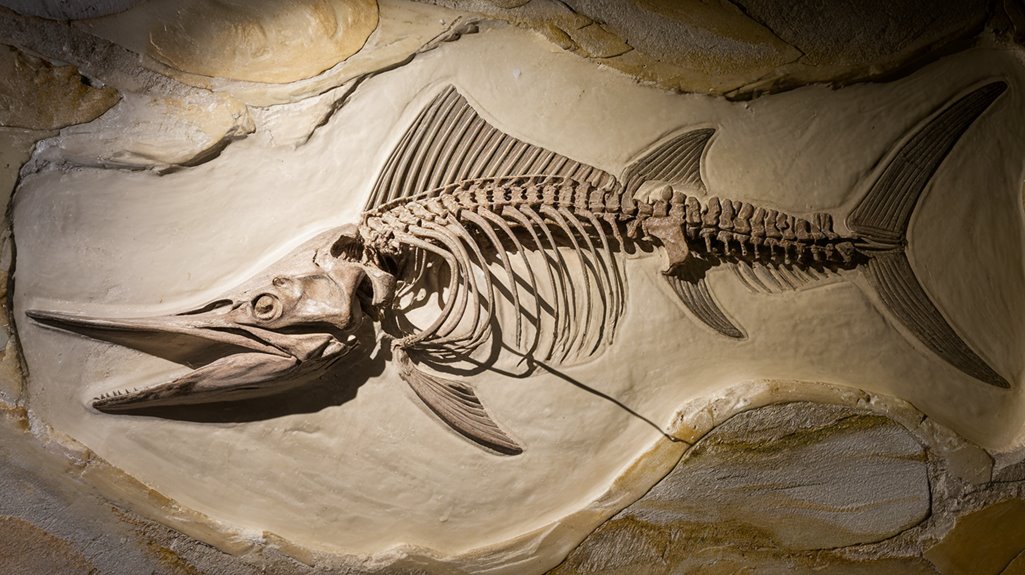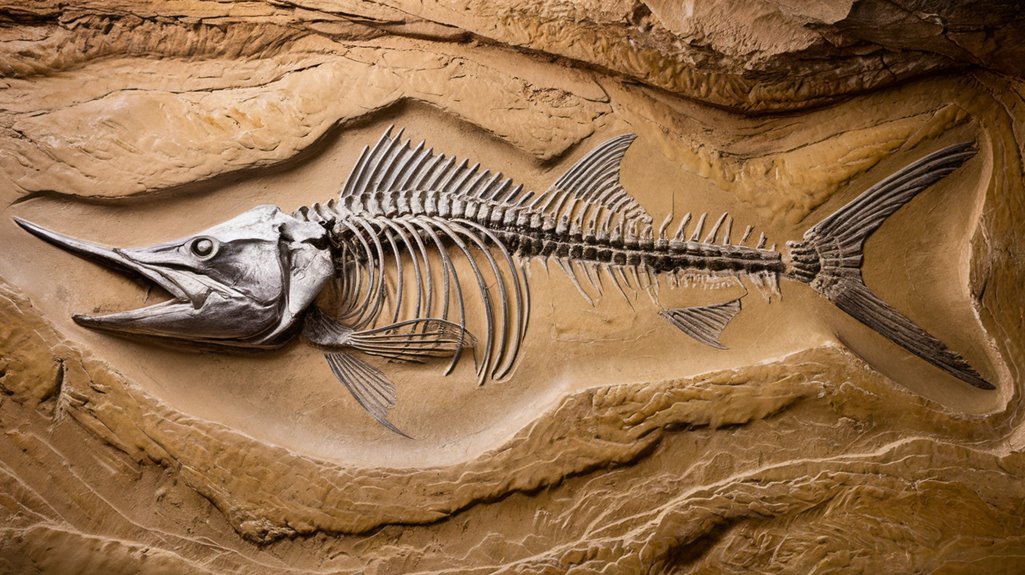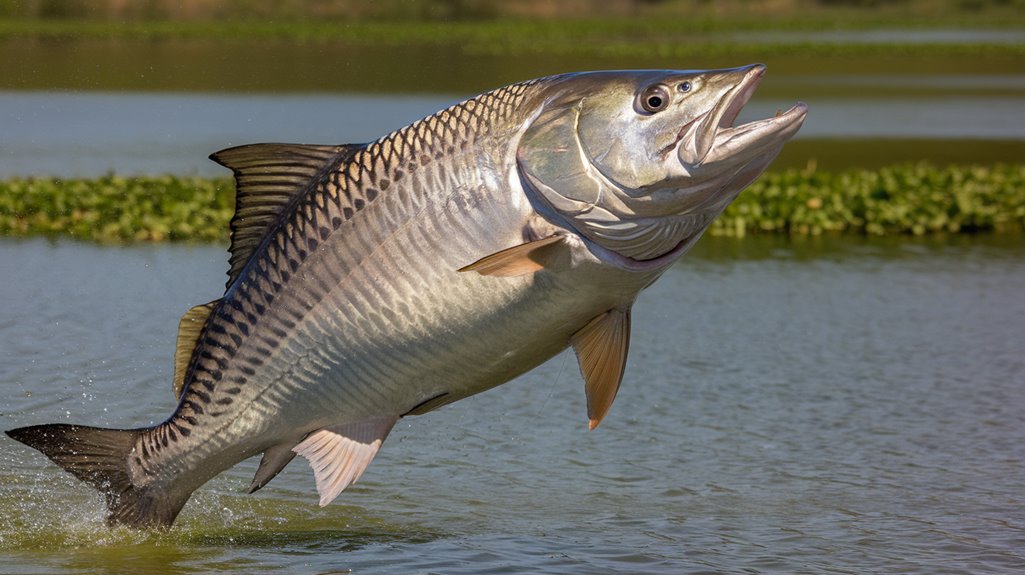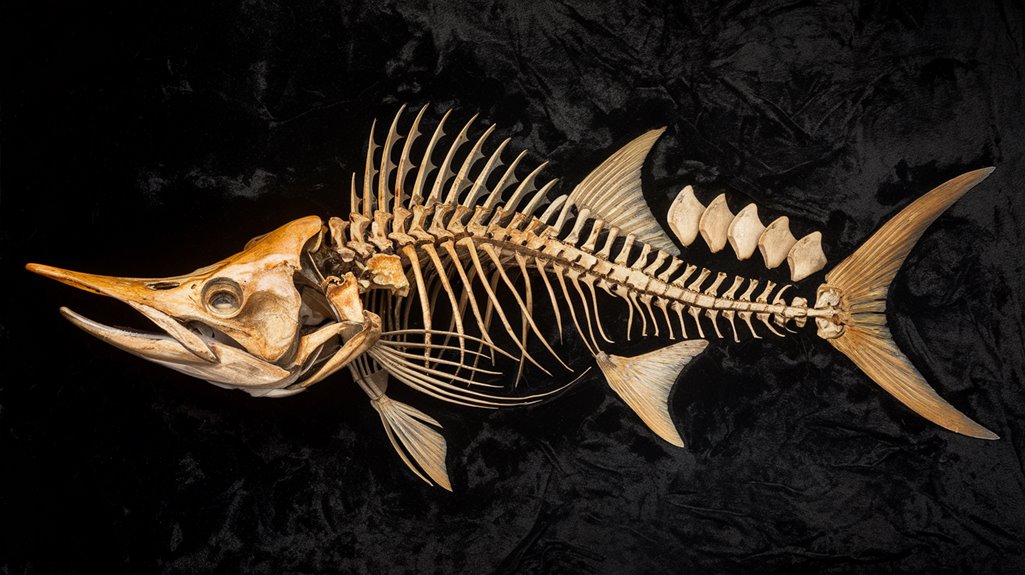When you examine the tarpon's 125-million-year evolutionary journey, you'll discover a masterclass in biological adaptation. This ancient fish's survival through multiple extinction events hasn't been coincidental – it's emerged from specific morphological innovations, including its specialized swim bladder and robust scaling system. As you consider the tarpon's remarkable persistence from the Cretaceous period to modern times, you'll find its story reveals vital insights about vertebrate evolution and species resilience.
- Key Takeaways
- Ancient Origins and Prehistoric Development
- Physical Adaptations Through Time
- Geographic Range Evolution
- Survival Mechanisms and Air-Breathing Evolution
- Migration Patterns Across Millennia
- Historical Impact on Human Communities
- Scientific Discovery and Classification Timeline
- Conservation Legacy and Future Prospects
- Modern Challenges and Species Resilience
- Frequently Asked Questions
- Conclusion
Key Takeaways
- Tarpon originated 125 million years ago during the early Cretaceous period and retained primitive features, earning its "living fossil" status.
- Large protective scales have remained unchanged since the Cretaceous, demonstrating the effectiveness of tarpon's evolutionary design.
- Tarpon developed a specialized swim bladder for air breathing, enabling survival across diverse aquatic environments.
- The species evolved exceptional adaptability between salt and fresh water, leading to successful colonization of varied coastal regions.
- Modern tarpon populations maintain ancient migration patterns while adapting to contemporary challenges through phenotypic plasticity.
Ancient Origins and Prehistoric Development

When tracing the evolutionary history of marine species, the tarpon stands out as one of nature's most enduring success stories, with ancestral origins dating back 125 million years to the early Cretaceous period. You'll find this ancient fish species among the order Elopiformes, a group that has maintained remarkably consistent anatomical features throughout the Mesozoic era. The tarpon's classification as a "living fossil" stems from its preserved primitive characteristics, including distinctive large flat scales and an archaic swim bladder structure. What's particularly fascinating is how these fish have demonstrated exceptional adaptability across diverse aquatic environments, from coastal waters to inland systems, while undergoing minimal evolutionary modifications. This evolutionary stability underscores the effectiveness of their biological design.
Physical Adaptations Through Time
Through their 125-million-year evolutionary journey, tarpon's physical adaptations showcase remarkable stability, particularly their large, protective scales that have remained largely unchanged since the Cretaceous period. You'll observe their most significant adaptation in their specialized swim bladder, which has evolved into a pseudo-respiratory organ enabling oxygen extraction from air when aquatic oxygen levels are insufficient. This distinctive respiratory mechanism proves especially vital for juvenile tarpon, who must access surface air to survive, demonstrating how this ancient species has refined its survival strategies while maintaining its core anatomical features.
Ancient Survival Features
As one of Earth's most enduring fish species, the tarpon has maintained its remarkable physical adaptations for approximately 125 million years. You'll find that these ancient survival features showcase the species' extraordinary resilience. Their specialized swim bladder enables oxygen extraction from air, an essential adaptation for surviving in oxygen-depleted waters, while their juvenile stage requires obligate air breathing.
- Advanced visual system with five cone cell types, including ultraviolet sensitivity
- Modified swim bladder functioning as a pseudo-respiratory organ
- Large, protective scales providing ideal hydrodynamic efficiency
- Preserved morphological characteristics demonstrating evolutionary success
These adaptations have remained largely unchanged through millions of years of evolution, proving their effectiveness across diverse aquatic environments. The tarpon's ability to thrive in various conditions demonstrates the sophistication of these ancient survival mechanisms.
Modern Breathing Adaptations
While maintaining their ancient respiratory features, modern tarpons have refined their breathing adaptations into a sophisticated dual-system that combines gill respiration with aerial oxygen absorption. You'll find their swim bladder has evolved into a highly vascularized organ, functioning as a supplementary respiratory system that enables direct oxygen extraction from the atmosphere.
This adaptation proves particularly essential during the juvenile stage, when tarpons are obligate air breathers and must regularly surface to fulfill their oxygen needs. The capillary-rich lining of their swim bladder enhances atmospheric oxygen absorption, allowing these fish to inhabit both oxygen-rich and oxygen-depleted environments. Their characteristic rolling behavior, combined with air-gulping capabilities, demonstrates the successful integration of these respiratory adaptations across diverse aquatic habitats, from freshwater to marine ecosystems.
Geographic Range Evolution

You'll find tarpon's evolutionary journey spanning approximately 125 million years has established remarkable migration patterns, from their ancient presence in the Atlantic corridors to their current Indo-Pacific distribution reaching Australia. Their remarkable capacity to navigate between salt and fresh water environments has enabled them to colonize diverse coastal regions, creating adaptability patterns that persist in modern populations from Virginia to Brazil. These geographic distribution shifts continue to evolve, with notable concentrations in areas like the Florida Keys, demonstrating the species' ongoing adaptation to changing marine ecosystems.
Ancient Migration Routes
Throughout their remarkable 125-million-year history, tarpons have demonstrated extraordinary adaptability in their migratory patterns and geographic distribution. You'll find that ancient migration routes of these prehistoric fish reveal complex behavioral patterns that evolved from their dual freshwater-marine lifestyle. Atlantic tarpon migrate across vast distances, maintaining ancestral pathways that reflect their species' remarkable resilience through geological epochs.
- Initial migration patterns encompassed extensive freshwater systems across North America and Europe
- Adaptation to changing oceanic conditions reshaped their migratory behaviors over millions of years
- Contemporary routes span from Virginia to Brazil, following ancient marine corridors
- Indo-Pacific populations developed distinct migration patterns, influenced by regional oceanographic features
These ancient migration routes continue to influence modern tarpon populations, preserving behavioral adaptations that have proven successful through millennia of environmental changes.
Coastal Adaptability Patterns
As marine environments have undergone dramatic changes over millions of years, tarpon have exhibited remarkable phenotypic plasticity in their coastal habitat selection and range expansion. You'll find Megalops atlanticus demonstrating unprecedented coastal adaptability from Virginia's temperate waters to Brazil's tropical seas, successfully colonizing diverse ecological niches throughout their evolutionary journey.
Their capacity to thrive in both marine and freshwater environments has shaped their geographic distribution, particularly evident in Florida tarpon fishing grounds, where they've established stable populations in estuaries and coastal waters. This adaptability pattern reflects a 125-million-year evolutionary strategy that's enabled tarpon to overcome environmental pressures through strategic habitat selection and migration. Their success in varying salinity levels and temperature gradients demonstrates how species persistence relies on physiological flexibility and behavioral adaptation.
Modern Distribution Shifts
While ancient tarpon populations once dominated vast oceanic regions, modern distribution patterns reveal significant geographic shifts that have shaped their current range dynamics. You'll find two distinct species exhibiting specialized habitat preferences: the Atlantic tarpon spanning Virginia to Brazil, and the Indo-Pacific tarpon thriving in Australasian waters. Their evolutionary journey, spanning 125 million years, has resulted in remarkable adaptations across diverse environments.
- Atlantic populations concentrate heavily in the Gulf of Mexico and Caribbean waters
- Indo-Pacific distribution extends throughout southern Asian coastal regions
- Both species demonstrate euryhaline capabilities, adapting to fresh and saltwater habitats
- Seasonal migrations follow thermal gradients, particularly during April-July spawning periods
This modern distribution reflects complex biogeographical patterns shaped by environmental pressures and the species' remarkable adaptive capacity.
Survival Mechanisms and Air-Breathing Evolution

Since evolving over 125 million years ago, the tarpon's remarkable air-breathing capability has remained one of nature's most efficient survival mechanisms. Through their specialized swim bladder, which functions as a pseudo-respiratory organ, you'll find these ancient fish have mastered survival in oxygen-depleted environments.
You'll notice this adaptation is particularly critical for juvenile tarpon, which are obligate air breathers requiring surface access for survival. This evolutionary trait enables them to colonize diverse habitats, including brackish waters where dissolved oxygen levels fluctuate considerably. Their characteristic rolling behavior at the surface isn't merely a spectacular display; it's a fundamental survival mechanism that's persisted unchanged for millions of years. This air-breathing ability has proven so successful that it's become a defining characteristic of the species, facilitating their remarkable adaptability across varied aquatic environments.
Migration Patterns Across Millennia
Throughout their 125-million-year existence, tarpon have developed sophisticated migration patterns that you'll find remarkably consistent across geological time scales. These ancient fish have expanded their range from the Atlantic Ocean to the Gulf of Mexico, adapting to diverse environmental conditions. You'll observe distinct migratory behaviors across their life stages, with juvenile tarpon seeking brackish and freshwater habitats for development, while adults exhibit long-distance movements tied to spawning and feeding cycles.
- Ontogenetic habitat shifts occur as juvenile tarpon evolve from coastal waters to estuarine environments
- Lunar-synchronized spawning migrations peak during spring months
- Thermally-driven southward movements occur in response to cold fronts
- Strategic movements between marine and freshwater systems optimize feeding opportunities on baitfish populations
Historical Impact on Human Communities
As recreational fishing emerged in the late 19th century, tarpon's remarkable strength and acrobatic displays catalyzed a transformative period in coastal communities, particularly along southwest Florida's shoreline. The watershed moment occurred in 1885 when William Halsey Wood documented the first tarpon caught on rod and reel, revolutionizing sport fishing paradigms. By 1894, you'd have witnessed an exponential surge in tarpon catches, with 438 recorded specimens demonstrating the species' economic influence from the Florida Keys northward. A.W. Dimmock's 1911 treatise on sustainable angling practices marked a pivotal shift in human-tarpon interactions, establishing catch-and-release protocols that continue to shape modern conservation efforts. The species' cultural significance has fostered a specialized angling demographic dedicated to both pursuit and preservation of these prehistoric gamefish.
Scientific Discovery and Classification Timeline
When scientists formally documented the tarpon in 1847, they recognized its distinctive large eyes by assigning the genus name Megalops, marking the beginning of its taxonomic classification. The scientific discovery timeline spans across millions of years, with fossil evidence confirming the tarpon's existence dating back approximately 125 million years. You'll find that modern taxonomic research has identified two distinct species within the Megalops genus, each adapted to specific geographic regions.
- Establishment of taxonomic classification in 1847 with genus name Megalops
- Confirmation of 125-million-year evolutionary lineage through fossil records
- Differentiation of Atlantic tarpon (Megalops atlanticus) species
- Classification of Indo-Pacific tarpon (Megalops cyprinoides) as separate species
This scientific progression, from fossil discovery to species classification, provides vital insights into the tarpon's evolutionary development and biodiversity patterns.
Conservation Legacy and Future Prospects
Despite their remarkable 125-million-year evolutionary resilience, tarpon populations now face unprecedented conservation challenges in the modern era. You'll find these ancient fish confronting habitat degradation and intensified fishing pressures, leading to their IUCN-listed threatened status.
Conservation efforts have evolved to meet these challenges through science-based management strategies. You're seeing increased implementation of catch-and-release protocols, which have become essential tools in population sustainability. Research initiatives tracking migration patterns and identifying critical habitats are shaping more effective protection measures. Through collaborative conservation networks, you're witnessing the integration of fishing communities, scientific organizations, and regulatory bodies working to secure tarpon's future. These coordinated efforts represent the species' best chance for survival, balancing human interaction with ecological preservation.
Modern Challenges and Species Resilience
While the Atlantic tarpon's 125-million-year evolutionary journey demonstrates remarkable adaptability, modern anthropogenic pressures have created unprecedented challenges for this ancient species. You'll find that despite their long lifespan of up to 55 years, tarpon populations are experiencing significant declines due to habitat degradation and fishing impacts. Conservation efforts must address multiple threats to guarantee species resilience.
- Recreational catch-and-release practices require optimization to minimize post-release mortality
- Population recovery faces impediments from reduced genetic diversity in impacted regions
- Migration corridor protection demands integration of cross-jurisdictional conservation strategies
- Critical habitat preservation necessitates collaborative ecosystem-based management approaches
The species' survival now depends on our ability to implement effective conservation measures while balancing human activities with biological imperatives, particularly in light of their slow maturation rates and vulnerable life stages.
Frequently Asked Questions
What Is the History of the Tarpon Fish?
You'll find tarpon's history spans 125 million years, predating T-Rex. Scientists first described Megalops atlanticus in 1847, with milestone achievements including the 1885 rod-and-reel catch weighing 93 pounds.
Why Is Tarpon Fishing Illegal?
You'll find that tarpon fishing's illegality stems from their vulnerable conservation status, slow reproductive cycles, and extended lifespan. Their critical role as apex predators requires protection through strict catch-and-release regulations.
How Old Is a 100 Pound Tarpon?
You'll find that a 100-pound tarpon typically reaches this mass between 10-15 years of age, though growth rates can fluctuate based on environmental conditions and available food resources.
What's so Special About Tarpon?
You'll find tarpon extraordinary for their specialized swim bladder that enables atmospheric breathing, five-cone visual system for UV detection, and 125-million-year evolutionary resilience as a highly adaptable predatory species.
Conclusion
You'll find that Megalops atlanticus exemplifies remarkable evolutionary persistence through its 125-million-year history. You're observing a species that's maintained its air-breathing capability via modified swim bladder physiology while adapting to trans-Atlantic distribution patterns. Through examination of its phylogenetic lineage, you'll note how the tarpon's anatomical conservatism and physiological plasticity have enabled its survival across major geological epochs and contemporary anthropogenic pressures.

